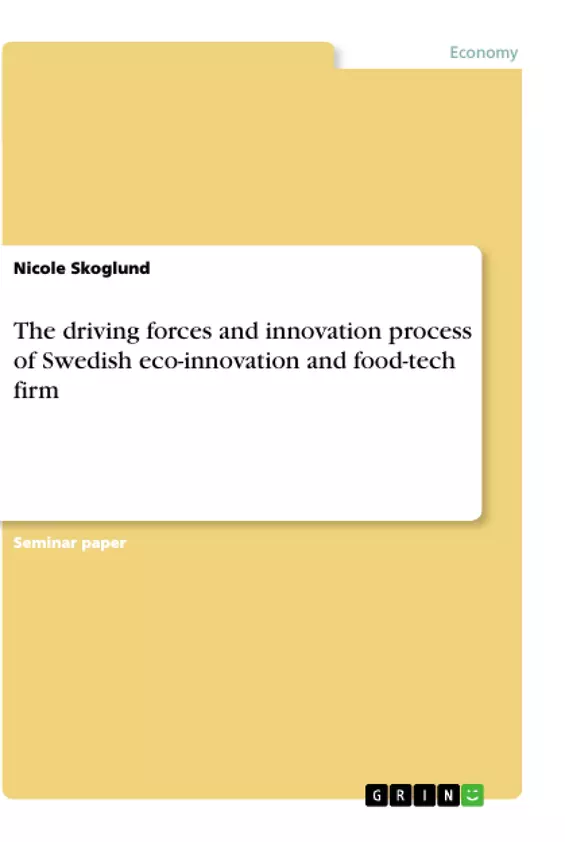The following piece will analyze Karma's driving forces and how clusters in the Swedish national innovation system (NTS) have allowed for Karma to flourish as an eco-innovation. Tn addition, this piece will investigate how the growth of these innovation clusters is related to cross-clustering, the close-knit interconnectedness between Stockholm's clusters.
142,000 tonnes of food waste was generated in Sweden in 2012, equivalent to 15 kg per person. At the same time, the food industry is accountable for approximately 8% of global greenhouse emissions. Although conflicting numbers on both global and regional food waste data exist, it is crystal clear that food waste is a crucial problem. Karma, a youthful start-up that focuses on turning surplus food into a business opportunity, was founded in the heart of Stockholm in 2016. The sustainable business model builds upon turning soon-to-be expired food into profit, allowing for partnering businesses to catch an additional revenue stream. A connection between consumers and businesses has been solidified through technological solutions, with one of the world's largest issues in mind; food waste.
Inhaltsverzeichnis (Table of Contents)
- Introduction
- Sweden's National Innovation System & Clusters
- The European Union has shown a great commitment to implementing eco-innovations as a mainstream strategy in Europe, through the Eco-Innovation Programme founded in 2008 which fuses business and environmental capabilities (European Commision, 2016).
- Karma as an Eco-Innovation
- Driving forces of Karma
Zielsetzung und Themenschwerpunkte (Objectives and Key Themes)
This document examines the driving forces and innovation process of Karma, a food-tech startup in Sweden that focuses on turning surplus food into a business opportunity. It analyzes how the company's success is rooted in the Swedish national innovation system (NIS) and the interconnectedness of innovation clusters within the Stockholm region.
- The role of Sweden's national innovation system (NIS) and its emphasis on research and development (R&D) in fostering innovation.
- The impact of innovation clusters and their interconnectedness in driving eco-innovation.
- The driving forces behind Karma's success, analyzing micro, industry, technological system, and macro levels.
- The importance of technological opportunities, partnership opportunities, and creative response in Karma's growth.
- The significance of eco-innovation and its contribution to sustainability and economic performance.
Zusammenfassung der Kapitel (Chapter Summaries)
- Introduction: This chapter introduces the problem of food waste and highlights Karma's innovative solution to turn surplus food into a business opportunity. It underscores the importance of technological solutions to address this global issue.
- Sweden's National Innovation System & Clusters: This chapter examines the strengths of Sweden's national innovation system, highlighting its high R&D expenditure and the presence of both large multinational firms and SMEs that engage in innovative practices. It introduces the concept of innovation clusters and their role in fostering collaboration and knowledge sharing.
- The European Union has shown a great commitment to implementing eco-innovations as a mainstream strategy in Europe, through the Eco-Innovation Programme founded in 2008 which fuses business and environmental capabilities (European Commision, 2016): This chapter discusses the EU's commitment to eco-innovation and argues that Stockholm's cluster matrix reveals a strong interconnectedness between ICTs and eco-innovation. It emphasizes the importance of sustainability in cluster development.
- Karma as an Eco-Innovation: This chapter defines eco-innovation and analyzes Karma's business model as a prime example of this approach. It underscores Karma's focus on reducing food waste and its role in promoting sustainable consumption behavior.
- Driving forces of Karma: This chapter explores the driving forces behind Karma's success, using Taalbi's four levels of analysis: micro-level, industry level, technological system level, and macro-level. It examines both positive opportunities and negative transformation pressure that have contributed to the company's growth.
Schlüsselwörter (Keywords)
The primary keywords and focus topics of this text include: eco-innovation, food waste, national innovation system, innovation clusters, cross-clustering, sustainability, food-tech, technological opportunities, partnership opportunities, creative response, micro-level analysis, industry-level analysis, technological systems level analysis, macro-level analysis.
- Quote paper
- Nicole Skoglund (Author), 2020, The driving forces and innovation process of Swedish eco-innovation and food-tech firm, Munich, GRIN Verlag, https://www.hausarbeiten.de/document/1009619


